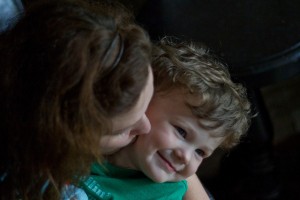
Autism spectrum condition (ASC) is a neurodevelopmental condition that affects social interaction, communication, interests and behaviour. Individuals who are diagnosed with ASC have difficulties with communicating with others, which can lead to difficulties with or a delay in their use of language. Some individuals with ASC remain non-communicative or non-verbal.
There is no “cure” for ASC, but a range of support programmes can help people with the condition to improve their communication skills. Techniques based in “Applied Behavioural Analysis” are widely recognised and utilise intensive behavioural support with some success for cognitive and language development (since Lovaas in 1987). It has been criticised for being too task or behaviour specific, meaning it can be repetitive for the child and not generalise well to other tasks.
Derived from the principles of ABA, Pivotal Response Treatment (PRT) focuses on targeting ‘pivotal’ areas, such as motivation to communicate. The aim is to improve child engagement to communicate by emphasising on encouraging the child to want to engage; using techniques such as child choice, task variation and using natural reinforcers (Koegel & Koegel, 2012). It focuses on treatment in the family environment; to help the method of learning to be reinforced and generalised across areas. Previous research has indicated that in 1.1 intensive family environments, parents can learn the interventions.
The aim of this study by Hardan et al (2014) was to examine whether parents can be taught interventions in a group environment.
The authors wanted to investigate two primary questions:
- Can parents learn Pivotal Response Treatment (PRT) from a 12-week group?
- Do children of parents involved in PRT interventions, exhibit greater improvements in functional communication skills than those receiving psychoeducation?

This RCT evaluated a Pivotal Response Treatment parent training group for targeting language deficits in young children with autism spectrum condition.
Methods
This study is a randomised controlled 12-week trial investigating the effectiveness of PRT in targeting functional communication deficits in young children with Autism.
Participants
The inclusion criteria for the children were; 2-6 years old; diagnosed with Autism based on the DSM-IV; with communication delays; able to vocalise with intent; with stable concomitant interventions (i.e. ABA); and at least one parent consistently participating.
Interventions
- The PRT group (PRTG) received 12 weekly sessions based on a manual. The psycho-education group (PEG) was a parent education programme on topics related to Autism.
- The PRTG were asked to practice PRT daily and video record at least 10 minutes a week for review in class, while the PEG were asked to video record 10 minute interactions at baseline, week 6 and week 12.
Primary outcome measures
- These were the ‘frequency of utterance’ from the child; looking at the types of utterances from the child, ranging from unintelligible or imitative utterances up to nonverbally prompted or spontaneous.
- They also looked at ‘parent fidelity of treatment’ implementation, i.e. whether the parents learnt the necessary techniques to teach PRT. To meet the fidelity criteria, parents had to get at least 80% ‘correct’ on each of the 6 PRT criteria during the observations.
These were obtained from a structured laboratory observation at baseline, at week 6 and at week 12 which was videotaped and scored by independent raters. The average inter-observer agreement was 88% (classed as a high level of agreement).
A number of secondary questionnaire-based outcome measures were investigated. These were communication inventories (Vineland-II Communication scale; Communicative Development Inventories; Social Responsiveness Scale) and the Clinical Global Impression Scale.
Results
A mixed effects regression model was used, with treatment group, time and their interaction as fixed-effect covariates.
53 subjects were included and randomised. Many of these children were receiving speech therapy of ABA treatment. These were continued as normal. Stratified randomisation was used to ensure that gender, age and intensity of concurrent therapies were fairly allocated across the groups, as these factors were thought to possibly affect the response to the intervention. 47 subjects completed treatment, with one PEG lost to follow up.
Communication
- Irrespective of treatment group, children showed significant improvement in total number of utterance across study time points (p =.005)
- Individuals receiving PRT showed greater improvement (p =.038)
- The treatment effect was most pronounced for imitative (p=0.001) and nonverbally prompted utterances (p=.002). Spontaneous utterances showed a non-significant trend towards a greater improvement in PRT.
Fidelity of implementation
- No parent met fidelity of implementation at baseline. In the PRTG, 21/25 parents met fidelity at week 12, while no parents in the PEG did
- Within the PRTG, caregivers who demonstrated fidelity at week 12 had children with a greater total and imitative utterances relative to those who did not meet fidelity.
Secondary outcome measures
- Exploratory measures such as the Vineland-II Communication scale showed that those receiving PRT showing larger improvements for expressive (p=0.004) and receptive language (p=0.028) raw scores
- No significant changes were found for the other standardised assessments of language
- The results indicated that those with higher baseline cognitive ability and nonverbal IQ responded well to the treatment: a higher Mullen Visual Reception scores was a predictor of treatment response (=.027) for total and imitative responses and accounted for 14% and 18% of the difference respectively.
Follow up
A 12 week follow-up was completed. The total number of utterances and number of imitative, verbally prompted and non-verbally prompted utterances suggested maintained improvements with treatment. There were no significant changes observed between week 12 and 24, i.e. did not continue to improve at same rate. Additionally, fidelity dropped to 48%.

Parents were able to learn Pivotal Response Treatment in a group format.
Discussion
With Autism diagnosis on the rise, it is vital that there are service delivery models in place that are effective to support families. Unfortunately, due to a lack of funding or widely available support programmes, this is not always as available as it should be. In the NHS at present, especially for children, it can be a minefield for parents to access a diagnosis for their child, let alone post-diagnostic support.
Summary
This RCT highlights that parents can learn PRT in a cost-effective group setting. The authors concluded that this RCT
Supports using PRT to improve functional communication skills for young children with ASD.
This research indicates that parents can be supported to motivate their child to make measurable improvements in their adaptive communication skills. This may be incredibly motivating for a stressed family who feel disempowered or even powerless in trying to engage with their child. PRT may be a supportive platform to do so. Even in the PEG, the improvement in some communication skills shows that education and a supportive environment can facilitate some positive change.
Although there was a lack of support for improvement in some assessments of language, this is perhaps to be expected as this was a parent-delivered package designed to focus on functional improvements and skills in everyday life, which is meaningful and may improve wider social behaviours.
Limitations and future research
There was only a moderate sample size with limited power. There was also some difficulty in judging how much time the parents spent implementing the intervention at home.
Further research might look at how the intervention impacts parental mood and stress, and how they feel about their family relationships. The adherence to the programme indicates that parents engage well and may enjoy it. It may also be useful to look at how the skills generalise across situations, i.e. whether the child’s improvement in skills is present with other interactive partners.
Links
Primary research
Hardan AY, Gengoux GW, Berquist KL, Libove RA, Ardel CM, Phillips J, Frazier TW, Minjarez MB. (2014) A randomized controlled trial of Pivotal Response Treatment Group for parents of children with autism. J Child Psychol Psychiatry. 2014 Aug;56(8):884-92. doi: 10.1111/jcpp.12354. Epub 2014 Oct 27. [Abstract]
Other references
Gengoux GW, Berquist KL, Salzman E, Schapp S, Phillips JM, Frazier TW, … Hardan AY. (2015) Pivotal Response Treatment Parent Training for Autism: Findings from a 3-Month Follow-Up Evaluation. Journal of Autism and Developmental Disorders, 1-10. [PubMed abstract]
Koegel RL, Koegel LK. (2012) The PRT Pocket Guide: Pivotal Response Treatment for Autism Spectrum Disorders. Brookes Publishing Company. PO Box 10624, Baltimore, MD 21285. [PDF book intro]

Pivotal response treatment is promising for children with autism https://t.co/WEwLbNVL6U #MentalHealth
RT iVivekMisra Pivotal response treatment is promising for children with autism https://t.co/qTGJfQZXeR #MentalHealth
@Ros_nelson29 presents RCT of #PivotalResponseTreatment groups for parents of children with #autism https://t.co/fiRnB6x3Y9
Pivotal response treatment is promising for children with autism https://t.co/129WLGj0T3
Pivotal response treatment is promising for children with #autism via @LearningDisElf https://t.co/fnVuF9XboU https://t.co/FPRuNKEFBx
RCT shows that parents of young children with autism can be taught Pivotal Response Treatment in a group environment https://t.co/fiRnB6x3Y9
Don’t miss: Pivotal response treatment is promising for children with autism https://t.co/fiRnB6x3Y9 #EBP
Pivotal response treatment is promising for children with autism https://t.co/2YZMEgoDH4 vía @sharethis